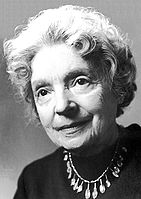
Nelly Sachs (10 December 1891 – 12 May 1970) was a Swedish poet
and playwright of Jewish German birth. Her experiences resulting from the rise of the Nazis in World War II Europe transformed her into a poignant spokeswoman for the grief and yearnings of her fellow Jews. Her best-known play is Eli: Ein Mysterienspiel vom Leiden Israels (1950); other works include the poems “Zeichen im Sand” (1962), “Verzauberung” (1970), and the collections of poetry In den Wohnungen des Todes (1947), Flucht und Verwandlung (1959), Fahrt ins Staublose (1961), and Suche nach Lebenden (1971). She was awarded with the Nobel Prize in Literature in 1966.
Born Leonie Sachs in Berlin-Schneberg, Germany, in 1891 to the wealthy natural rubber and gutta-percha manufacturer Georg William Sachs (1858-1930) and his wife Margarete, ne Karger (1871-1950), she was educated at home because of frail health. She showed early signs of talent as a dancer, but her protective parents did not encourage her to pursue a profession. She grew up as a very sheltered, introverted young woman and never married. She pursued an extensive correspondence with, and was friends with, Selma Lagerlf and Hilde Domin. As the Nazis took power, she became increasingly terrified, at one point losing the ability to speak, as she would remember in verse: “When the great terror came/I fell dumb.” Sachs fled with her aged mother to Sweden in 1940. It was her friendship with Lagerlf that saved their lives: shortly before her own death Lagerlf intervened with the Swedish royal family to secure their release from Germany. Sachs and her mother escaped on the last flight from Nazi Germany to Sweden, a week before Sachs was scheduled to report to a concentration camp. They settled in Sweden and Sachs became a Swedish citizen in 1952. Living in a tiny two-room apartment in Stockholm, Sachs cared alone for her mother for many years, and supported their existence by translations between Swedish and German. After her mother’s death, Sachs suffered several nervous breakdowns characterized by hallucinations, paranoia, and delusions of persecution by Nazis, and she spent a number of years in a mental institution. She continued to write even while hospitalized. She eventually recovered sufficiently to live on her own, though her mental health would always be fragile. Her worst breakdown was ostensibly precipitated by hearing German speech during a trip to Switzerland to accept a literary prize. However, she maintained a forgiving attitude toward a younger generation of Germans, and corresponded with many German-speaking writers of the postwar period, including Hans Magnus Enzensberger and Ingeborg Bachmann.
In the context of the Shoah, her deep friendship with “brother” poet Paul Celan is often noted today. Their bond was described in one of Celan’s most famous poems, “Zrich, Zum Storchen” (“Zrich, The Stork Inn”). Sachs and Celan shared Holocaust and the fate of the Jews throughout history, their interest in Jewish and Christian mysticism, and their literary models; their imagery was often remarkably similar though developed independently. Their friendship was supportive during professional conflicts. Celan also suffered from artistic infighting (Claire Goll‘s accusations of plagiarism) during a period of frustration with the reception of his work. When Sachs met Celan she was embroiled in a long dispute with Finnish-Jewish composer Moses Pergament over his musical adaptation of her stage play Eli: Ein Mysterienspiel vom Leiden Israels. In Celan, she found someone who understood her own anxiety and hardships as an artist. Sachs’ poetry is intensely lyrical and reflects some influence by German Romanticism, especially in her early work. The poetry she wrote as a young woman in Berlin is more inspired by Christianity than Judaism and makes use of traditional Romantic imagery and themes. Much of it concerns an unhappy love affair Sachs suffered in her teens, with a non-Jewish man who would eventually be killed in a concentration camp. After Sachs learned of her only love interest’s death, she bound up his fate with that of her people and wrote many love lyrics ending not only in the beloved’s death, but in the catastrophe of the Holocaust. Sachs herself mourns no longer as a jilted lover but as a personification of the Jewish people in their vexed relationship to history and God. Sachs’ fusion of grief with subtly romantic elements is in keeping with the imagery of the kabbalah, where the Shekhinah represents God’s presence on earth and mourns for the separation of God from His people in their suffering. Thus Sachs’ Romanticism allowed her to develop self-consciously from a German to a Jewish writer, with a corresponding change in her language: still flowery and conventional in some of her first poetry on the Holocaust, it becomes ever more compressed and surreal, returning to a series of the same images and tropes (dust, stars, breath, stones and jewels, blood, dancers, fish suffering out of water, madness, and the ever-frustrated love) in ways that are sometimes comprehensible only to her readers, but always moving and disturbing. Though Sachs does not resemble many authors, she appears to have been influenced by Gertrud Kolmar and Else Lasker-Schler in addition to Paul Celan. In 1961 she became the inaugural winner of the Nelly Sachs Prize, a literary prize awarded biennially by the German city of Dortmund, and named in her honour. When, with Shmuel Yosef Agnon, she was awarded the 1966 Nobel Prize in Literature, she observed that Agnon represented Israel whereas “I represent the tragedy of the Jewish people.” Following her death from intestinal cancer in 1970, Nelly Sachs was interred in the Norra begravningsplatsen in Stockholm. Her possessions were donated to the National Library of Sweden. A memorial plaque commemorates her birthplace, Maaenstrae 12, in Schneberg, Berlin; where there is also a park, in Dennewitzstrae, named after her. A park on the island of Kungsholmen in Stockholm also bears her name.Overview
Life and Career
Paul Celan and Lyrical Poetry